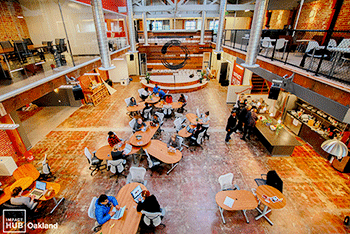The West Humboldt Park Development Council (WHPDC) works to improve economic conditions in a Chicago neighborhood with staggering unemployment—roughly 75 to 80 percent by some accounts, though the official rate, as in many places, is much lower—a high-crime past, and the low rumble of looming gentrification.
The neighborhood’s future is unwritten. But its past definition of success is also problematic.
In 2002, a group of developers joined WHPDC to renovate the Kedzie Shopping Center. The project brought 70 jobs to the area. So far, so good. However, the marquee businesses that would come to occupy the plaza—Aldi’s, a European grocery chain specializing in off-brand, discounted products, and a Chase Manhattan Bank branch—had corporate headquarters elsewhere, so they didn’t circulate profits within West Humboldt Park to a great extent. And the rest of the businesses that typify Kedzie (Subway, Game Stop, a low-budget Chinese food restaurant, and the cell phone provider Cricket) are not the sorts of employers that consistently offer local residents health care, wages above the minimum, or even full-time employment.
West Humboldt Park is a community whose residents are not accustomed to demanding good jobs; aside from Kedzie, the most available employment opportunities are security gigs with mom-and-pop corner markets. Conventional wisdom would argue that beggars should not be choosers. Still, in the mind of WHPDC executive director Chet Jackson, as crowning achievements go, Kedzie leaves a lot to be desired.
“To me, a good job is one that has a career path,” Jackson says. “At least it has a living wage attached to it. There’s no way in the world that you should be working 40 hours a week and coming home with less than $200 and trying to survive on it and support a family. To me, that’s just unacceptable.”
Fortunately, notions of how to generate good jobs and keep the developers who promise them honest have progressed a great distance in the years since that shopping center was redone.
“Access to credit is fundamental for very small business owners,” says Amanda Ballantyne, network director for the Seattle-based Main Street Alliance. “There’s a gap between when a business becomes bankable and [when it becomes] eligible for economic development money.”
Solid credit is scarce among would-be entrepreneurs in Chet Jackson’s Westside Chicago neighborhood. One thing it does have in abundance is cooks. There’s the woman moving baked goods out of her kitchen who’s concerned that her operation could begin growing so fast that her books stop making sense. Consider also the guy who delivers meals to area shut-ins and was just recently turned down for a loan by a community development financial institution (CDFI). That institution’s lending standards, while more relaxed than the Chase branch down at the shopping center, were still too stringent for his start-up to qualify.
“There are a lot of home-based businesses, so one of my challenges is to move that home-based business into an incubator, and from the incubator into an accelerator,” says Jackson. “These are businesses that aren’t tremendously complicated. For instance, there are people in the neighborhood who bake. The challenge becomes, ‘How do we get you out of your kitchen and into an incubator to grow you—slowly, but in a sustainable manner?’”
Two thousand miles away from West Humboldt Park, Jose Corona may have a plan that addresses Jackson’s challenge—and also addresses the problem of the Kedzie shopping center head-on.
“We have an investment fund called Fund Good Jobs,” explains Corona, CEO of Oakland-based Inner City Advisors, which puts “not only the number of jobs [expected], but job quality metrics into the agreements of the investment. So, in the term sheet we can say if they meet specific job quality metrics for a period of time, there’s an interest abatement that goes to them.” The interest can go from 8 percent to 7 to 6 or lower.
“We provide ‘interest rebates’—usually 2 percent reduced from a variety of [starting] interest rates—to incentivize the good jobs metrics,” explains Sean Daniel Murphy, president and managing partner of Fund Good Jobs. Last year, Fund Good Jobs was the main funding source of Oakland’s Impact Hub, a 16,000-square-foot “co-working” space whose other primary sources of backing came via a Kickstarter campaign.
ICA/Fund Good Jobs’ start-ups are asked to develop job projections every year. Fund Good Jobs also tracks job access and job quality, defining access as purposely hiring and retaining folks who are underrepresented in the workforce—ex-offenders, products of the foster care system, and people with limited education, among other criteria. A “quality job” is defined by living wages, health benefits, and professional development opportunities. These definitions are adhered to with an eye toward the companies’ stage of development and its growth plans.
Every deal that the nonprofit makes is incentive based. According to ICA and Fund Good Jobs leadership, the present portfolio of businesses are all adhering closely to their arrangements and there’s “every belief” they will continue.
Companies that Fund Good Jobs invests in get the help of ICA’s Talent Management program to meet their job creation and quality goals. The support includes pro-bono consulting, connection to volunteer advisors, and strategic human resources and talent acquisition support. The idea is to ensure that each hiring opportunity is being supported by hands-on people management, and is done in partnership with the Alameda County Social Services Agency. “This is where our investment companies receive the most critical support in reaching the good jobs metrics,” Murphy explains.
Sometimes it’s a matter of choosing to focus on an industry that tends to produce good jobs anyway. One such story opens dismally, four years ago, with the Eaton Corporation abandoning its historic North Milwaukee facility for an office park in suburban Wauwatosa, Wisc., taking with it close to 150 jobs. The mayor was appalled, but the tax credits Eaton demanded were beyond what Milwaukee could afford.
In an urban narrative older than tax credits themselves, an 184,000-square-foot facility was left vacant. This northwest part of town has a poverty rate of 33.1 percent to go along with 13.4 percent unemployment, and was hard-pressed to weather the loss.
Enter the Northwest Side Community Development Corporation, a CDFI with more than 30 years of service in a depressed section of Milwaukee. Bent on replacing the vanished positions, the NWSCDC partnered with local prototype company Jonco Industries to obtain just over $10 million in federal funding—the core $628,750 coming from the Department of Human Services, the Office of Community Services, and the Community Economic Development program—to transition the single-use facility into a multi-tenant, $33 million project called Century City Tower, which includes the Energy Innovation Center (EIC), a 65,000-square foot incubator. In exchange for low-cost funding, Jonco agreed to create a minimum of 40 new jobs over three years. While the NWSCDC did not impose job quality requirements, its loan committee did request starting salary information and uses it in the underwriting process. NWSCDC also encourages borrowers to provide paid time off and 401(k) matching funds to their employees, among other benefits.
Today, Century City Tower is the anchor of an industrial corridor makeover, and 45 of the lost, above-minimum-wage jobs have been recovered—36 of them going to low-income residents.
“Jonco laid the groundwork for future job growth in the neighborhood,” reports Sarah Greenberg, NWSCDC’s director of lending. “If companies leaving the EIC once they’re ready to expand and staff up stay in the area, that will be a big win for the Northwest side of Milwaukee.”
Complicating things for community economic developers is the fact that there can be tensions between those who want to focus on good jobs and residents who want work in whatever form it takes, or internal tensions within an organization that supports struggling small businesses and job seekers.
“I can tell you that over the years there’s been a creative tension between people in the small business creations programs and the jobs programs,” says Richard Thal, executive director of the Jamaica Plain Neighborhood Development Corporation (JPNDC). He says parts of his Boston community look at proposed chain developments and think, “Well, 10 or 11 dollars [an hour] is a start.”
“Some of the participants in those jobs programs are anxious to get those jobs,” says Thal. And meanwhile, some of the start-up businesses JPNDC works with are daunted by the prospect of being asked to pay higher wages. “One of the things that’s a challenge is the impression that it’s a grand sort of social engineering exercise,” Thal opines. He hasn’t yet found a way to nudge JPNDC’s business borrowers more toward job access or higher pay, or fully reconcile the internal tension between these two values in the different parts of his organization. JPNDC does, however, coach seekers of work “on valuing their worth and the importance of negotiating a fair wage.”
“And with some of the business owners,” Thal adds, “we stress that the better you treat your employees, the more likely they are to be loyal, motivated, and long-term employees.”
Retention matters for both workers and employers, and is a necessary part of the goal of creating employment that improves lives for the long haul. “Retention is definitely an issue,” Greenberg says. “It’s not so much that people are going [to work] elsewhere, but that people are simply falling back out of the job market. Our workforce retention board touts a 50 percent retention rate after one year of placement, and that’s considered very good.”
Inner-City Advisors, which in addition to Impact Hub has helped launch Revolution Foods and Luminalt Solar Energy Solutions, sees retention as less about remedying the oft-claimed “soft skills deficits” of low-income workers and more about matching prospective workers with companies that suit their abilities and interests from the outset.
“The approach that we take is to be pretty selective of the companies that we work with,” says Corona. “If we see that there’s not a lot of opportunity for the employees, not a lot of upward mobility, both in terms of wages or position, then we try to get that from the beginning. It doesn’t mean that’s a bad business, but part of our definition of a good job is career ladder opportunities.”
Any employee, from an underrepresented community or not, is bound to struggle in an office culture that is toxic, regardless of the wages earned and thus does not have a good job. Workforce development entities don’t always take employment environments into account, never mind intangibles that contribute to on-the-job success.
“We take what we call a ‘best fit’ recruiting model,” says Corona. “If it’s someone coming out of prison, traditional workforce [development programs] right now, what they do is say, ‘Hey, if you want to get back into the workforce, here’s a job. Go to this interview and go find a job.’ But what ends up happening is that there’s really, really high turnover in that kind of approach. It might not be the right fit. We take that extra time to say, ‘Hey, what are those talents?’ ‘What are you good at?’ ‘What are you passionate about?’—then find the employer that will give ’em that.”
“You can’t put someone in a baker position in a bakery when they really want to be in construction or solar installation,” he explains. And yet, “that’s what the traditional workforce sector does. ‘Here’s a body, here’s a job—let’s put them in that job.’ And they either get fired or they quit.”
Along with support and lower interest rates, a lender or other business support agency can also help businesses of all sizes conceive of their workers—both prospective and current—as “investments, rather than expenses on the ledger,” says Main Street’s Ballantyne. “There’s the business benefit that, if you give people paid sick time, if you pay them a decent wage, if you give them access to the other benefits they need, they won’t have the same level of turnover as at Wal-Mart. It involves a different business model.”
There are some fairly new tools at the disposal of a business that is willing to self-assess the quality of its jobs. The Self-Sufficiency Standard, for example, created by the University of Washington’s Center for Women’s Welfare, defines the amount of income needed, with tax included, to meet basic needs without public assistance. Created in 1996 and now used in 37 states, this regionally specific standard for what constitutes a living wage takes into account costs of housing, child care, food, transportation, and health care, among other factors in calculating real costs of living, and can be a helpful reality check to answer the question of “Can my workers survive on the wages I’m offering?”
B-Lab, the organization that certifies B-corporations (the B stands for benefit) has an impact assessment survey that comes in 20- and 90-minute versions. The online checklist determines a business’s impact on every involved stakeholder. It’s like “a way of seeing how healthy am I as a business when it comes to treating my workers,” says Miquela Craytor, vice president of industrial initiatives and income mobility at the New York Economic Development Corporation. If, “after reviewing that diagnostic, the business wants to commit to improve on their health … the business is then offered to take advantage of resources and programming to improve that score.”
Craytor’s department works with partners such as the city’s Department of Small Business Services in order to give one-on-one support to the diagnosed companies. The New York EDC also has in the works services that focus on employee benefits, on-the-job training, and employee engagement.
There’s another, more intangible tool for making this case that cannot be boiled down to an online survey or even a living wage algorithm: Creative communication. The habits and expectations of employers and economic developers are ingrained, particularly where HR is concerned, so that established protocols can be conflated with necessities of commerce. Or, as Craytor says, “They just want to do what they do.”
“My background is planning,” she notes, “so I’m kind of a generalist and kind of feel half the time like my role is interpretation. In workforce, you know the challenges of the communities you’re trying to serve, you understand the barriers to skills training and other educational difficulties. You know that system very well, you know the issues that are facing that client base. And so, you talk about your area of expertise really from the lens of the job seeker.”
Meanwhile, “a developer of a property is looking at the real estate nuances of getting a project under construction built. They have deadlines with money out the door for construction budgets. They’ll sign a lease with a tenant and then, in their mind, as long as the tenant is paying their rent they don’t really care if the tenant has found people [meeting the jobs criteria] because that’s the tenant’s responsibility.”
Craytor, whose most recent achievement is HireNYC, a program that connects local companies with prospective workers in search of good jobs, points out that developers don’t necessarily see it as their role to guarantee that tenants who sign leases with them are in touch with workforce personnel.
“If I as a city government entity say, ‘Hey developer, make sure when you’re hiring people that you talk to your workforce folks,’ the developer will say, ‘Sure, sure.’ And they might make a call, but they won’t necessarily see all of the value or the interconnections or make the additional efforts because it’s not sort of in their DNA. That’s not to say there aren’t developers who don’t do that, but oftentimes what I see in economic development is that what gets in the press release—or what people pay attention to—is ‘OK we’re going to do it.’ But the real work comes after the press release.”
To bridge this gap, Craytor uses a leverage that’s possessed by every municipality with properties that businesses rent.
“When you have all of this stuff that we ask people to do, and people are afraid of change, it’s a complicated thing. These businesses have their own HR processes, their way of doing it. They don’t want to be told that they have to give extra notice and report out,” Craytor says. “So, the leverage comes in with, ‘You’re doing what you’re trying to do on a city-owned property and for that reason you need to give us some extra time to give you candidates.’ Having leadership to back that up is mission critical, and we’re thankfully in a place in this administration where we can do that.”
This article was made possible by a Surdna Foundation grant supporting equitable economic development reporting.






Comments